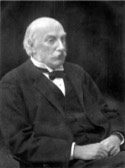Clement-Jones family - Person Sheet
Clement-Jones family - Person Sheet
Spouses
1Evelyn Georgina Mary BALFOUR, 8721
FatherJames Maitland BALFOUR , 8712
MotherLady Mary Blanche Gascoigne CECIL , 8713
Notes for John William STRUTT 3rd Baron Rayleigh
John William Strutt, 3rd Baron Rayleigh, OM (12 November 1842 – 30 June 1919) was an English physicist who, with William Ramsay, discovered the element argon, an achievement for which he earned the Nobel Prize for Physics in 1904. He also discovered the phenomenon now called Rayleigh scattering, explaining why the sky is blue, and predicted the existence of the surface waves now known as Rayleigh waves. Rayleigh's textbook, The Theory of Sound, is still referred to by acoustic engineers today.
Biography
Strutt was born in Langford Grove, Essex, and in his early years suffered from frailty and poor health.[1] He attended Harrow School, before going on to the University of Cambridge in 1861 where he studied mathematics at Trinity College. He obtained a Bachelor of Arts degree (Senior Wrangler and 1st Smith's prize) in 1865, and a Master of Arts in 1868.[2] He was subsequently elected to a Fellowship of Trinity. He held the post until his marriage to Evelyn Balfour, daughter of James Maitland Balfour, in 1871. He had three sons with her.[3] In 1873, on the death of his father, John Strutt, 2nd Baron Rayleigh, he inherited the Barony of Rayleigh.
He was the second Cavendish Professor of Physics at the University of Cambridge (following James Clerk Maxwell), and held this position from 1879 to 1884. He first described dynamic soaring by seabirds in 1883, in the British journal Nature. From 1887 to 1905 he was Professor of Natural Philosophy at Cambridge.
Around the year 1900 Lord Rayleigh developed the duplex (combination of two) theory of human sound localization using two binaural cues, interaural phase difference (IPD) and interaural level difference (ILD) (based on analysis of a spherical head with no external pinnae). The theory posits that we use two primary cues for sound lateralization, using the difference in the phases of sinusoidal components of the sound and the difference in amplitude (level) between the two ears.
Lord Rayleigh was elected Fellow of the Royal Society on 12 June 1873, and served as president of the Royal Society from 1905 to 1908. From time to time Lord Rayleigh participated in the House of Lords; however, he spoke up only if politics attempted to become involved in science. He died on 30 June 1919, in Witham, Essex.[3] He was succeeded, as the 4th Lord Rayleigh, by his son Robert John Strutt, another well known physicist.
[edit]
Biography
Strutt was born in Langford Grove, Essex, and in his early years suffered from frailty and poor health.[1] He attended Harrow School, before going on to the University of Cambridge in 1861 where he studied mathematics at Trinity College. He obtained a Bachelor of Arts degree (Senior Wrangler and 1st Smith's prize) in 1865, and a Master of Arts in 1868.[2] He was subsequently elected to a Fellowship of Trinity. He held the post until his marriage to Evelyn Balfour, daughter of James Maitland Balfour, in 1871. He had three sons with her.[3] In 1873, on the death of his father, John Strutt, 2nd Baron Rayleigh, he inherited the Barony of Rayleigh.
He was the second Cavendish Professor of Physics at the University of Cambridge (following James Clerk Maxwell), and held this position from 1879 to 1884. He first described dynamic soaring by seabirds in 1883, in the British journal Nature. From 1887 to 1905 he was Professor of Natural Philosophy at Cambridge.
Around the year 1900 Lord Rayleigh developed the duplex (combination of two) theory of human sound localization using two binaural cues, interaural phase difference (IPD) and interaural level difference (ILD) (based on analysis of a spherical head with no external pinnae). The theory posits that we use two primary cues for sound lateralization, using the difference in the phases of sinusoidal components of the sound and the difference in amplitude (level) between the two ears.
Lord Rayleigh was elected Fellow of the Royal Society on 12 June 1873, and served as president of the Royal Society from 1905 to 1908. From time to time Lord Rayleigh participated in the House of Lords; however, he spoke up only if politics attempted to become involved in science. He died on 30 June 1919, in Witham, Essex.[3] He was succeeded, as the 4th Lord Rayleigh, by his son Robert John Strutt, another well known physicist.
[edit]


